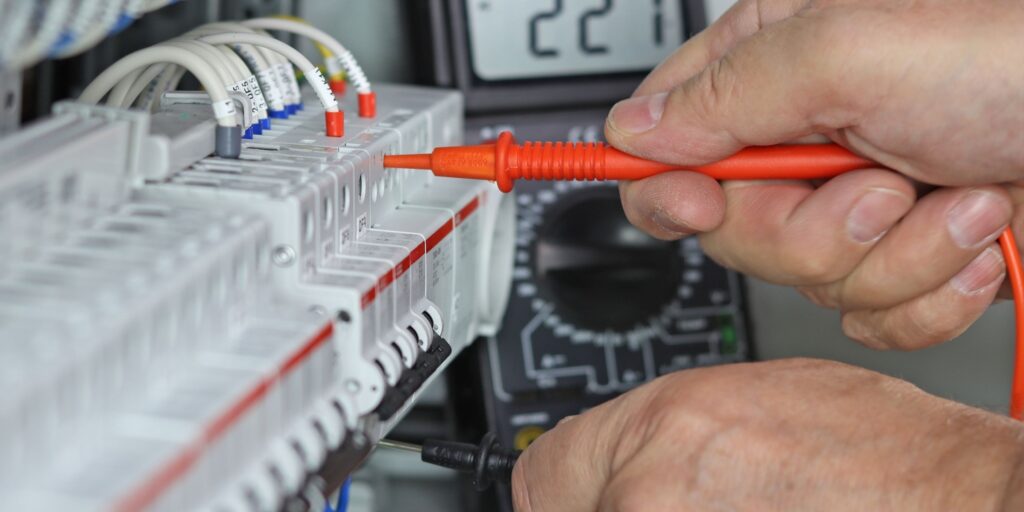No products in the basket.
Have you ever wondered about the safety of the electrical devices you use every day? Ensuring that these devices are safe is important, especially in workplaces. This is where PAT testing comes into play. But what does PAT testing stand for? PAT stands for Portable Appliance Testing. Therefore, in this blog, we will explore everything you need to know about PAT testing.

What Does PAT Testing Stand For?
PAT testing stands for Portable Appliance Testing, a process that involves inspecting and testing electrical equipment to ensure it’s safe to use. The primary goal of portable appliance testing is to identify potential electrical hazards, such as faulty wiring, damaged insulation, or malfunctioning components, which can lead to electrical shocks, fires, or even fatalities.
Why is Portable Appliance Testing Important?
Firstly, portable appliance testing is vital for maintaining safety in the workplace. Electrical appliances that are not regularly checked can develop faults over time, which might lead to electrical fires or shocks. Thus, regular PAT testing helps in identifying these issues before they become dangerous.
Moreover, this testing is often a legal requirement. Many countries have regulations mandating regular portable appliance testing to ensure workplace safety. Failure to comply with these regulations can result in legal consequences, including fines or business shutdowns. Therefore, adhering to PAT testing schedules is not just about safety but also about compliance with legal standards.
How is Portable Appliance Testing Performed?
It’s essential to understand the testing process to ensure electrical equipment is safe and compliant. Here’s an overview of the testing process:
- Visual Inspection: A qualified PAT tester conducts a visual inspection of the electrical equipment to identify any signs of damage, wear, or tear.
- Earth Continuity Test: The PAT tester performs an earth continuity test to ensure the equipment’s earthing system is functioning correctly.
- Insulation Resistance Test: The PAT tester conducts an insulation resistance test to ensure the equipment’s insulation is intact and functioning correctly.
- Polarity Test: The PAT tester performs a polarity test to ensure the equipment’s wiring is correctly connected.
What Equipment Requires Portable Appliance Testing?
It’s important to identify the types of electrical equipment that require PAT testing. Here are a few examples:
- Portable Appliances: Appliances, such as kettles, toasters, and microwaves, require portable appliance testing.
- IT Equipment: IT equipment, such as computers, printers, and scanners, needs portable appliance testing.
- Power Tools: Portable Appliance Testing requires power tools, such as drills, saws, and sanders,
Who Should Perform Portable Appliance Testing?
Portable appliance testing should be performed by a competent person with the necessary training and experience. This can include:
- Trained Employees: Employees who have received training in PAT testing can perform the tests.
- External Contractors: Businesses can hire external contractors who specialise in PAT testing.
- Facilities Managers: Facilities managers can also perform PAT testing as part of their role.

How Often Should Portable Appliance Testing Be Carried Out?
Determining the frequency of PAT testing to ensure electrical equipment remains safe and compliant is very important. The frequency of PAT testing depends on various factors, including:
- Equipment Type: Different types of equipment require portable appliance testing at varying frequencies. For example, portable appliances may require PAT testing every 12 months, while IT equipment may require this testing every 24 months.
- Usage: Equipment that is used frequently may require more frequent portable appliance testing than equipment that is used less frequently.
- Environment: Equipment that’s used in harsh environments, such as construction sites or outdoor events, may require PAT testing more often than equipment used in office environments.
Common Misconceptions About Portable Appliance Testing
Despite its importance, there are several misconceptions about portable appliance testing. Some of the following include:
- Only for Large Businesses: Some believe that PAT testing is only necessary for large businesses. However, any business that uses electrical appliances should consider PAT testing, regardless of size.
- Once is Enough: Another common misconception is that once an appliance is tested, it does not need to be tested again. In reality, regular testing is necessary to ensure ongoing safety.
- Only for New Appliances: Some think that only new appliances need testing. However, all appliances, regardless of age, should be tested regularly.
Conclusion
Overall, portable appliance testing is a crucial process that ensures electrical equipment is safe and compliant. By understanding what PAT testing stands for and its significance in electrical safety, you can take steps to prevent electrical accidents and ensure your equipment is safe to use. Remember, this testing is not a one-time process; it requires regular testing and maintenance to ensure electrical equipment remains safe and compliant.




